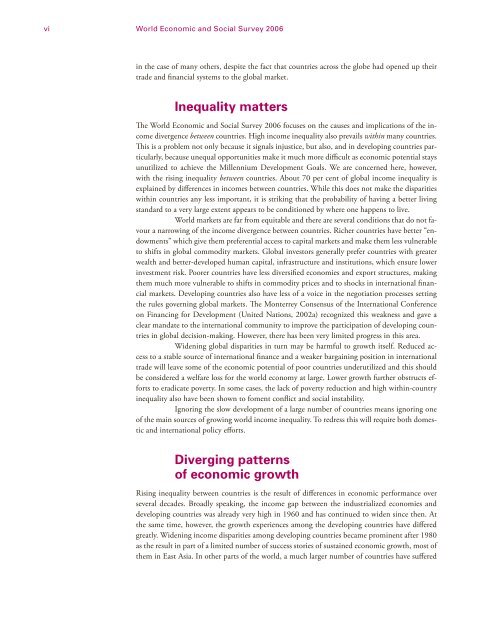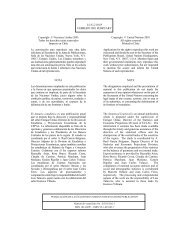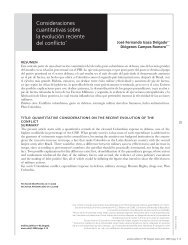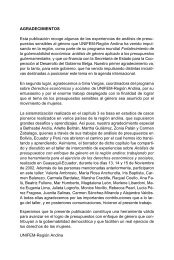Diverging Growth and Development - Biblioteca Hegoa
Diverging Growth and Development - Biblioteca Hegoa
Diverging Growth and Development - Biblioteca Hegoa
You also want an ePaper? Increase the reach of your titles
YUMPU automatically turns print PDFs into web optimized ePapers that Google loves.
vi World Economic <strong>and</strong> Social Survey 2006<br />
in the case of many others, despite the fact that countries across the globe had opened up their<br />
trade <strong>and</strong> fi nancial systems to the global market.<br />
Inequality matters<br />
Th e World Economic <strong>and</strong> Social Survey 2006 focuses on the causes <strong>and</strong> implications of the income<br />
divergence between countries. High income inequality also prevails within many countries.<br />
Th is is a problem not only because it signals injustice, but also, <strong>and</strong> in developing countries particularly,<br />
because unequal opportunities make it much more diffi cult as economic potential stays<br />
unutilized to achieve the Millennium <strong>Development</strong> Goals. We are concerned here, however,<br />
with the rising inequality between countries. About 70 per cent of global income inequality is<br />
explained by diff erences in incomes between countries. While this does not make the disparities<br />
within countries any less important, it is striking that the probability of having a better living<br />
st<strong>and</strong>ard to a very large extent appears to be conditioned by where one happens to live.<br />
World markets are far from equitable <strong>and</strong> there are several conditions that do not favour<br />
a narrowing of the income divergence between countries. Richer countries have better “endowments”<br />
which give them preferential access to capital markets <strong>and</strong> make them less vulnerable<br />
to shifts in global commodity markets. Global investors generally prefer countries with greater<br />
wealth <strong>and</strong> better-developed human capital, infrastructure <strong>and</strong> institutions, which ensure lower<br />
investment risk. Poorer countries have less diversifi ed economies <strong>and</strong> export structures, making<br />
them much more vulnerable to shifts in commodity prices <strong>and</strong> to shocks in international fi nancial<br />
markets. Developing countries also have less of a voice in the negotiation processes setting<br />
the rules governing global markets. Th e Monterrey Consensus of the International Conference<br />
on Financing for <strong>Development</strong> (United Nations, 2002a) recognized this weakness <strong>and</strong> gave a<br />
clear m<strong>and</strong>ate to the international community to improve the participation of developing countries<br />
in global decision-making. However, there has been very limited progress in this area.<br />
Widening global disparities in turn may be harmful to growth itself. Reduced access<br />
to a stable source of international fi nance <strong>and</strong> a weaker bargaining position in international<br />
trade will leave some of the economic potential of poor countries underutilized <strong>and</strong> this should<br />
be considered a welfare loss for the world economy at large. Lower growth further obstructs efforts<br />
to eradicate poverty. In some cases, the lack of poverty reduction <strong>and</strong> high within-country<br />
inequality also have been shown to foment confl ict <strong>and</strong> social instability.<br />
Ignoring the slow development of a large number of countries means ignoring one<br />
of the main sources of growing world income inequality. To redress this will require both domestic<br />
<strong>and</strong> international policy eff orts.<br />
<strong>Diverging</strong> patterns<br />
of economic growth<br />
Rising inequality between countries is the result of diff erences in economic performance over<br />
several decades. Broadly speaking, the income gap between the industrialized economies <strong>and</strong><br />
developing countries was already very high in 1960 <strong>and</strong> has continued to widen since then. At<br />
the same time, however, the growth experiences among the developing countries have diff ered<br />
greatly. Widening income disparities among developing countries became prominent after 1980<br />
as the result in part of a limited number of success stories of sustained economic growth, most of<br />
them in East Asia. In other parts of the world, a much larger number of countries have suff ered
















